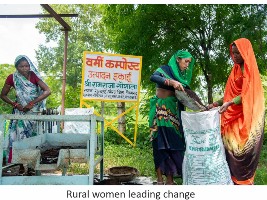Climate Change – the Story of This Century
Can you do any media report today without factoring in climate change? Unlikely. Are you covering a fashion show? Talk to the designers and they will tell you about the problems of getting good cloth; first because cotton and silk productions have been hit by climate change and second because higher temperature means threads keep tearing on the loom more often. Covering foreign affairs? You cannot get away from the squabbles over legal and illegal migration and visas, all worsened because more and more people are finding it impossible to earn their livelihoods from agriculture – a direct impact of climate change. Covering a Test match? The international cricket season has shortened in tandem with the shortening winter. Covering the budget? Look at the amount that has gone into renewable energy. Covering a fight between two groups in a village? Chances are high that the fight is over water or crops, both hit by climate change. Doing a feature on folk songs? Find a contemporary folk song that does not talk of climate change impacts, though it is very likely that the phrase climate change will not be used. Report on high blood pressure? You will find the worst cases are along the coast, among people who cannot afford bottled water and have to drink water that is increasingly becoming saline due to rising sea levels, another impact of climate change.
 All these are apart from the more obvious impacts: the early heatwave of 2022 that hit Rabi crops, especially wheat; the increasingly erratic monsoon where we have fewer rainy days but more rainfall on those days, leading to a constant cycle of droughts and floods; thermal power plants shutting down every summer because there is not enough water to wash the coal before burning it; the plight of fishermen as their catch moves away from warmer coastal waters; the salinity-hit coastal farms on which hardly anything grows; the drying up of Himalayan springs on which residents depend all over for their water needs; the flash floods as ever-widening glacial lakes burst their banks.
All these are apart from the more obvious impacts: the early heatwave of 2022 that hit Rabi crops, especially wheat; the increasingly erratic monsoon where we have fewer rainy days but more rainfall on those days, leading to a constant cycle of droughts and floods; thermal power plants shutting down every summer because there is not enough water to wash the coal before burning it; the plight of fishermen as their catch moves away from warmer coastal waters; the salinity-hit coastal farms on which hardly anything grows; the drying up of Himalayan springs on which residents depend all over for their water needs; the flash floods as ever-widening glacial lakes burst their banks.
A report on the issues around climate change need not always be a doom and gloom story. India is at the early stage of a major transition in the way the country is generating energy. There are many instances of new green businesses just as there are many examples of climate-smart agriculture, energy-efficient buildings, and so on.
Similar to the earth’s atmosphere, climate change is also enveloping all our activities. Policymakers need to take it into account whether they are planning a new road or a new crop, a new health centre or a new factory. Journalists must take it into account as well. At the same time, it is important to recognise that climate change is not responsible for all our woes, and many problems are being created as a result of deforestation, pollution, ill-planned infrastructure projects, or inappropriate cropping patterns, to give a few examples. Climate change is a threat multiplier in all these cases, but it is not the only threat.
A former Secretary General of the United Nations had described climate change as the challenge of our times. For journalists, it is the biggest story of the century. That is why it makes eminent sense for every journalist to understand what is going on in the climate change arena. Some journalists shy away from trying to understand it, perhaps because they have been told it is a technical subject. In essence, it is not. All of us studied the water cycle in middle school. At a very basic level, climate change is accelerating the water cycle. Think of it that way – the understanding and the stories will fall into place.
Joydeep Gupta
joydeep.gupta@thirdpole.net
The author is South Asia Director of Third Pole
This article is written for Development Alternatives






Leave a Reply